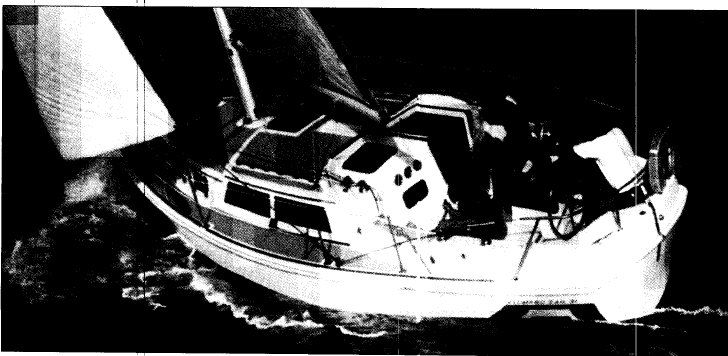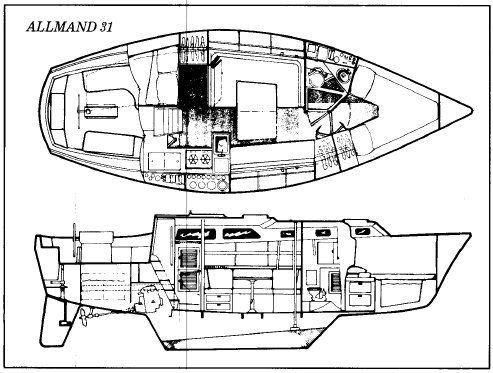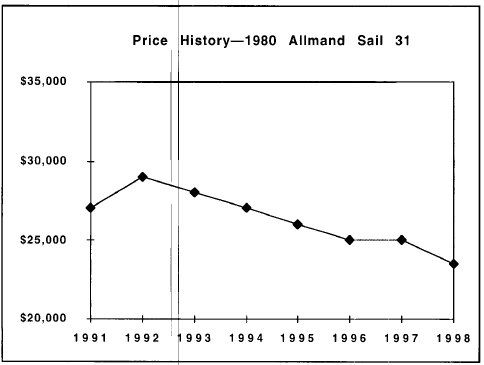During the hey day of fiberglass sailboat production in the 1970s, there were seemingly more small builders than today. Alas, the industry recession of the mid-and late 1980s wiped them out. But the boats they build still exist. One of interest is the Allmand 31, built by Allmand Boats, Inc. of Hialeah, Florida. The company also sold the Allmand 23 and Allmand 35.
Allmand was foremost a builder of power boats, dating to at least 1965. Most were inboard-powered between 28 and 34 feet, though they also built smaller open and cuddy cabin boats for outboards and sterndrives. Like a handful of other powerboat builders, the energy crunch of the 1970s and the “greening of America” prompted Allmand to try its hand at sailboats. And like those other builders, the result of its efforts was a somewhat unorthodox looking boat. The Allmand 31 isn’t as misshapen as Bayliner’s Buccaneers, but it’s not what you would call a classic. The super graphic letter “A” (for Allmand) on the aft topsides didn’t seem to integrate well with the rest of the boat, but fortunately that was later discontinued.

The Allmand 31 first appears in the BUC Research Used Boat Price Guide in 1979, the same year it was featured in SAIL magazine’s annual directory. Production ceased about 1985, according to BUC Research, the same year it went out of business. Curiously, BUC shows that Allmand built only sailboats the last several years of its existence.
The Design
An old brochure lists Walter Scott and T.R. Allmand as the designers of the 31. The design is quite conservative in most respects, though a notable exception is its wide 11′ 4″ beam and long 27′ 8″ waterline, which account for the generous room below. Most owners surveyed indicated its interior spaciousness as the principal reason they bought the Allmand 31.
The hull has a conventional vertical transom that looks larger than it really is due to the tan cockpit coaming across the stern. The bow has a pleasing rake to it with a slight concave curve which suggests the inten tions of a clipper bow that was wisely left on the drawing room floor. The sheer is fairly flat and contemporary.
The coach roof has a small step in it for added headroom (6′ 4″) in the main cabin. This dates the design somewhat, though it can be a hand some detail. One disadvantage, how ever, is the problem of leading lines such as halyards from the base of the mast aft to the cockpit.
The combination of two overhead hatches, large fixed portlights and smaller opening portlights, of which seven were standard, provide good ventilation and light. As an option, one could pay for additional opening portlights-up to 11 in all.
Underwater, the Allmand 31 has a long, shoal cruising fin and rudder mounted on a partial skeg. The shoal ?keel draws just 3′ 10″, which makes the boat well suited to Florida Bay and Bahamas cruising, for which, one may presume, she was intended. While the problems associated with centerboards are eliminated, banging of the board in the trunk, broken pennant, barnacles obstructing the trunk, etc.) there is a definite tradeoff in terms of upwind sailing performance.

The Allmand 31 displaces 11,100 lbs. or l2,850 lbs. depending on which brochure you believe, giving it a displacement/length (D/L) ratio of 230 or 259. (The brochure indicating the heavier displacement also lists length waterline or LWL as 27′ 11″ and draft as 4′ 0”.)
Two sail areas are listen in one brochure—471 sq. ft. for the “Cruising Model” and 485 sq. ft. for the “Racing/Cruising Model.” The extra 14 sq. ft. came from having a 2′ taller mast. Lead instead of iron ballast was used for the Racing/Cruising Model, which should make it stiffer. The sail area/displacement (SA/D) ratios for the two are 15.2 and 15.6, somewhat low numbers. The shoal keel precludes a large rig that might jeopardize stability.
Speaking of stability, the boat derives much of its form stability from its wide beam. Excessive heeling, which could happen with a taller rig, would probably result in poor handling characteristics.
In any case, these relatively low SA/D ratios suggest a fairly slow boat, a conclusion supported by the boat’s owners.
Construction
Our files do not tell a great deal about how the boat was constructed, so we will assume that the hull is solid fiberglass and the deck cored with balsa. A full-length fiberglass pan was molded to incorporate the cabin sole and berths, then, while the hull was still in the mold, “resin bonded and fiberglassed into the hull.” Teak-faced plywood covers up most traces of the pan. It does not appear that an overhead liner was used in the main cabin; rather the raw fiberglass was spray painted. This never looks particularly smooth, but a real benefit of not using an overhead liner is that the bulkheads may be tabbed with fiberglass to the underside of the deck.
The hull deck joint is strong and should be leakproof. Resin was laid into the joint before lowering the deck onto the hull, then stainless fasteners (one suspects screws) were drilled in, and then the entire inside of the joint fiberglassed over. It would require a Sawz-all to cut the deck off the hull. Hopefully, such radical surgery will never be necessary!
As noted above, ballast was either iron or lead, the latter being preferable in terms of its specific gravity and resistance to corrosion. It can be difficult keeping paint on an iron keel. One should expect to have to take it down to bare metal every so many years, clean, prime and repaint.
Upper and double lower shrouds are led to 1-1/2″ wide by 1/4″ thick stainless steel chainplates that pass through the deck (right next to the cabin trunk) and are anchored to structural members behind the settees. As such, they are exposed inside, which isn’t all bad, as stainless survives longest when exposed to the air. The downside is that one might occasionally find them in the way when stowing things on the shelves behind the set tees. On deck, there are raised bosses where the chainplates enter the deck, and these should help keep water out.
The mast is stepped on deck. A stainless steel compression post sits on the ballast. The owner of a 1981 model, who was dismasted due to what he said was a faulty Merriman turnbuckle, recommended “beefing up the mast step and compression post top.” He also suggested heavier standing rigging, but admitted it was “only because of our mishap.”
Underwater through-hulls are fitted with bronze sea cocks, which are part of an electrical grounding system, along with the rudderstock and drive shaft.
We received no reports of hull blishters, though a few owners noted gelcoat flaws on deck.
Early boats, had contrasting non-skid colors, such as blue, on the otherwise white deck. Later, a beige color was available for the entire deck, that to our eye at least, looks better.
Interior
Early 31s have the so-called tri-cabin layout, with a 6 4 V-berth forward, 6 U-shaped settee-dinette and single settee amidships, and an aft cabin on the prt side, which is enclosed by a door and features a hungingin locker. The berth measures 6 6 x 4 6. The builder thougthlfuylly made a fold-away top to the bulkhead at the forward end of the aft cabin that provides ventilation nd keeps the cabin from imparting claustrophobia. Close it when youre cold and want to cuddle; otherwise wed leave it open, if for no other reason tan to help prvent mildew.
A limited number of Allmand Sail 31/II models were built without the aft cabin enclosure. The brochure states, the basic difference is that the main cabin is wide open. Many bulkheads and doors have been eliminated. It is a boat designed for a young couple or small family. Teak trim is minimal (and so is maintenance). Tiller steering is standard. Price of the 31/II was dropped about $5,000.
The galley is to starboard of the companionway ladder. It is not large, but includes the basics – sink, gimbaled stoae, 8-cubi-foot icebook, pressure water and storage compartments outboartd and behind the sink.
There is no nav station, so chart work will take place on the dinette table, wihich folds out to seat up to seven.
As Allmand 31 owners know, there is a lot of room below. Berths for seven is unusual in a boat this size, but the Allmand does it without appearing to have crammed them in.
Performance
The PHRF ratings for the Allmand 31, in fleets around the country, rnage from 168 to 210, with an average of 192. This puts it on a part with the full-keel Allied Seabreeze 35, faster than the Alberg 30 and Bayfield 30 at 222, and much slower than a Beneteau 305 at about 150. But then max speed isn’t what this boatr is about.
Nevertheleadd, owners report that off the wind she does quite well, owing in part to its long waterline. One woner recommends using a MPS (multi-purpose spinnaker) for improved performance.
Upwind is another matter. Shoal draft and wide beam hurts upwind performance, especially in choppy water, said the owner os a 1979 model on the Alabam Gulf Coast.
A strong suit of the 31 is its tremendous form stability. Cannot get gunwale under, said more than one woner. Shell heel only so far and then stop. Just one owner said hed ever had the rail under, and that in 30 knots of sind and rough seas. Most said theyd tried but couldnt.
Handling, too, is extolled by owners. Balanced easily, light weather helm, said the owners of a 1980 model in Indiana.
The most common auxiliary was a 16-hp. M20 Universal diesel. Owners rate its reliability as above average and accessibility as average to below average. (So what else is new on a sailboat?) A few owenrs with 21-hp. Ecati engines complained about parts availability. An owner of a Renault 16D said his engine has benn very reliable.
One owner said his creusing speed is 5+ knots, but the theoretical hull speed I aoubt 7 knots… if you can find the power to push the load. Sixteen horses for six tons isn’t a lot.
Maneuverability under power is good. Lilke a lot of boats, however, getting the boat to go where you want in reverse takes some practice. One owner said h can drive a slalom course in reverse, but no one else agreed with him.
Conclusion
We were somewhat surpised, and impressed by the number of people living aboard the Allmand 31. For her size, she certainly does offer much space below and in the cockpit (one owner said shell easily sit six or seven in the T-shaped cockpit).
The wide beam gives her a good deal of initial stability, though this is not the kind of hull form that you want to capsize as inverse stability will be greater than on a narrower boat (and one with a deeper keel). Still, level sailing is always appreciated. And the long waterline helps deliver speed in wont of a bigger rig. Some say the 31 will tack through 84 true, others as much as 90 or 100. Either way, this is probably acceptable to many when the tradeoff is a comfy crusiing boat.
Owners rate construction as above average.
According to the BUC Research Used Boat Price Guide, used Allman Sail 31 prices range from about $20,000 to $25,000. We checked Soudnings for additional listings and found two Allmand 31s for sale, a 1983 for $19,900, with the 16-hp. Universla diesel, and another of unspecified vintage for $29,500.
For comparison, the same column of boats included a 1985 Island Packet 31 for $59,500, several 1979 Bombay Clippers between $22,000 and $28,900, a 1983 Cal 31 for $33,900 and a 1986 Hunter 31 for $33,500.

We wont say that the Allmand is better built than these other 31-footers, but it is certainly not the worst either.
It is safe to say that if bought in the low $20s, the Allamnd 31 would represent a good value. When looking for explanations for its low price, one is tempted to blame the stigma of a sailboat built by a powerboat company, that real sailors wouldnt consider such a boat. While we have serious reservations about some sailboats by powerboat companies, the Allmand 31 doesn’t appear to deserve that rap. Just ask one of her many owners.


































I have a little problem with a 1982 31ft Allmand I just purchased. Put in a new cutlass last week and noticed the shaft is not centered in the throughhull. The service yard said the engine mounts need to be replaced or adjusted. I see no way of getting to that area. Any suggestions. By the way, the .engine is a refit jammed in pretty tight.
Congratulations Christopher on your Allmand. I bought mine 3 years ago. Its a 1981 31ft tri cabin. I replaced the top rudder shelf, and a few more bits and bobs but cant help you with your cutlass. Im sure the forums will have something.. Happy sailing! sherry
My first boat as a retiree was a 1984 Allmand 31. Loved it. My wife could push and pull it around docks and pylons. of course, I needed another 3-4 feet (don’t we all) so I now have a 35′ Catalina.
I still miss my Allmand.